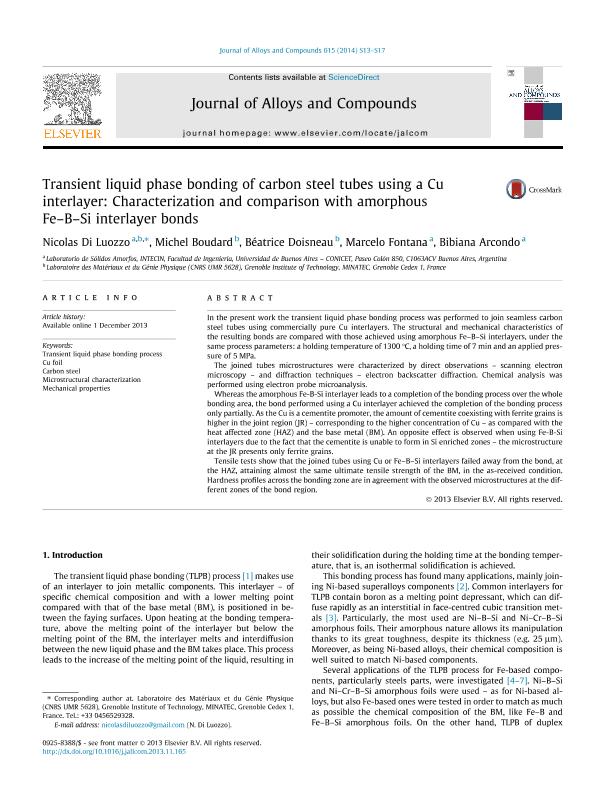Artículo
Transient liquid phase bonding of carbon steel tubes using a Cu interlayer: Characterization and comparison with amorphous Fe–B–Si interlayer bonds
Di Luozzo, Nicolás ; Boudard, Miguel Santiago; Doisneau, Béatrice; Fontana, Marcelo
; Boudard, Miguel Santiago; Doisneau, Béatrice; Fontana, Marcelo ; Arcondo, Bibiana Graciela
; Arcondo, Bibiana Graciela
 ; Boudard, Miguel Santiago; Doisneau, Béatrice; Fontana, Marcelo
; Boudard, Miguel Santiago; Doisneau, Béatrice; Fontana, Marcelo ; Arcondo, Bibiana Graciela
; Arcondo, Bibiana Graciela
Fecha de publicación:
12/2013
Editorial:
Elsevier
Revista:
Journal of Alloys and Compounds
ISSN:
0925-8388
Idioma:
Inglés
Tipo de recurso:
Artículo publicado
Clasificación temática:
Resumen
In the present work the transient liquid phase bonding process was performed to join seamless carbon steel tubes using commercially pure Cu interlayers. The structural and mechanical characteristics of the resulting bonds are compared with those achieved using amorphous Fe–B–Si interlayers, under the same process parameters: a holding temperature of 1300 °C, a holding time of 7 min and an applied pressure of 5 MPa.
The joined tubes microstructures were characterized by direct observations – scanning electron microscopy – and diffraction techniques – electron backscatter diffraction. Chemical analysis was performed using electron probe microanalysis.
Whereas the amorphous Fe-B-Si interlayer leads to a completion of the bonding process over the whole bonding area, the bond performed using a Cu interlayer achieved the completion of the bonding process only partially. As the Cu is a cementite promoter, the amount of cementite coexisting with ferrite grains is higher in the joint region (JR) – corresponding to the higher concentration of Cu – as compared with the heat affected zone (HAZ) and the base metal (BM). An opposite effect is observed when using Fe-B-Si interlayers due to the fact that the cementite is unable to form in Si enriched zones – the microstructure at the JR presents only ferrite grains.
In the present work the transient liquid phase bonding process was performed to join seamless carbon steel tubes using commercially pure Cu interlayers. The structural and mechanical characteristics of the resulting bonds are compared with those achieved using amorphous Fe–B–Si interlayers, under the same process parameters: a holding temperature of 1300 °C, a holding time of 7 min and an applied pressure of 5 MPa. The joined tubes microstructures were characterized by direct observations – scanning electron microscopy – and diffraction techniques – electron backscatter diffraction. Chemical analysis was performed using electron probe microanalysis. Whereas the amorphous Fe-B-Si interlayer leads to a completion of the bonding process over the whole bonding area, the bond performed using a Cu interlayer achieved the completion of the bonding process only partially. As the Cu is a cementite promoter, the amount of cementite coexisting with ferrite grains is higher in the joint region (JR) – corresponding to the higher concentration of Cu – as compared with the heat affected zone (HAZ) and the base metal (BM). An opposite effect is observed when using Fe-B-Si interlayers due to the fact that the cementite is unable to form in Si enriched zones – the microstructure at the JR presents only ferrite grains. Tensile tests show that the joined tubes using Cu or Fe–B–Si interlayers failed away from the bond, at the HAZ, attaining almost the same ultimate tensile strength of the BM, in the as-received condition. Hardness profiles across the bonding zone are in agreement with the observed microstructures at the different zones of the bond region.
Archivos asociados
Licencia
Identificadores
Colecciones
Articulos(INTECIN)
Articulos de INST.D/TEC.Y CS.DE LA ING."HILARIO FERNANDEZ LONG"
Articulos de INST.D/TEC.Y CS.DE LA ING."HILARIO FERNANDEZ LONG"
Citación
Arcondo, Bibiana Graciela; Fontana, Marcelo; Doisneau, Béatrice; Boudard, Miguel Santiago; Di Luozzo, Nicolás; Transient liquid phase bonding of carbon steel tubes using a Cu interlayer: Characterization and comparison with amorphous Fe–B–Si interlayer bonds; Elsevier; Journal of Alloys and Compounds; 615; Sup. 1; 12-2013; 13-17
Compartir
Altmétricas



